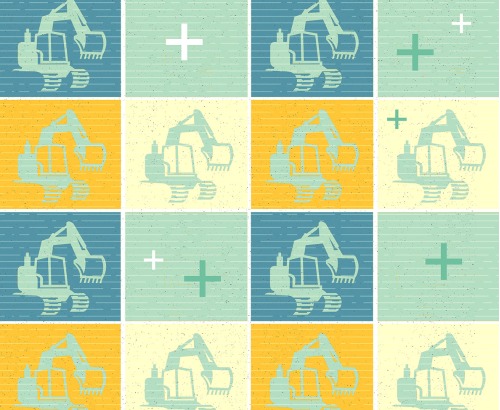Fleet Management Dynamics in a Post-Pandemic World
Following best practices in fleet management can mitigate key challenges and create a competitive advantage for companies that maintain a high level of fleet performance.
What a difference a few months make! As 2020 opened, heavy civil and other equipment-intensive contractors were looking forward to a strong construction season, with almost all segments of the construction industry pushing full steam ahead. In fact, the biggest challenge most contractors saw on the horizon was that the continuously tightening labor market might make it difficult to staff projects. Even in early March, the tone at CONEXPO and other industry events was one of cautious optimism, with most attendee contractors believing that the disruption caused by the coronavirus would be of limited duration and impact.
Of course, we know differently now. Six weeks into the pandemic, construction unemployment had reached nearly 17%, moderating somewhat by the end of June, but still high at 10.1%1—with the broader U.S. economy experiencing its worst unemployment crisis since the Great Depression. Most states are facing dismal financial futures in the near term, with social distancing rules and quarantines leading to sharp declines in gas tax revenues, tolls and user fees. According to Dodge Data & Analytics, infrastructure project starts through July 2020 were down 20% versus last year,2 and many more planned projects may be deferred until funding prospects improve or clients achieve better visibility on their financial circumstances.
While the picture for infrastructure and other equipment-intensive contractors is still better than that of the vertical construction market, the entire construction industry faces significant headwinds. Unlike firms in the building space—with lower asset intensity—equipment-intensive contractors face distinct challenges in dealing with their fleet assets and managing their cash positions. Fortunately, following best practices in fleet management can help mitigate these challenges while creating a competitive advantage for companies that maintain a high level of performance in this area.
Best Practices in Fleet Management Create Optionality
The best time to squeeze costs out of capital-intensive equipment fleets was last year; the next best time is right now. As the newness of the external economic shock fades, it became more and more apparent that it was time to prepare for a VUCA (Volatile, Uncertain, Complex, Ambiguous) world. However, you don’t have to pursue a departmental transformation to score some quick wins; there are many actions your firm can take immediately to improve its fleet situation.
There are two overlapping concepts central to our discourse. The first is that there is value in flexibility (optionality) because it can be used to reduce risk. In a VUCA environment, the value of company flexibility increases just as in financial markets, the value of options increases with market volatility. Many buyers of financial options do so to hedge and reduce risk in their portfolios. Likewise, efficiently adding flexibility to a firm’s equipment fleet decreases risk exposure.
The second concept is that equipment access— not necessarily ownership—is what really matters. With increasing availability of rentals, firms have more ability to put equipment to work that they do not own. While ownership has many advantages, the flexibility of non-ownership access to equipment is particularly resonant in a VUCA world, where the value attributed to flexibility inherently increases.
For fiscal year 2018, the average net fixed assets to total assets for a heavy civil or infrastructure contractor in FMI’s database was 31%. With equipment representing the lion’s share of net fixed assets, the fleet is the prime place to start in the quest to build your firm’s flexibility. There are three key ways to increase flexibility (i.e., optionality) that are valid in the best of times and essential anytime there is a potential for market tightening. While optimizing and building flexibility into a large equipment fleet is a significant endeavor that often requires organizational changes, there are tactical actions one can take today to get some quick wins in the near term.
A Highly Utilized Fleet Is an Efficient Fleet
There are three critical questions about utilization that contractors should answer:
-
Are you tracking utilization, and do you believe the data accurately reflects reality?
Ask your superintendents and equipment operators what, if anything, is wrong with the utilization data. They will likely tell you if the numbers differ from what they’re seeing on the front lines. Among the common problems we see are bad telemetry data and manual data-entry inconsistencies. When even a small portion of the automated usage readings are clearly off, doubt is naturally cast on all readings. What good are the readings if some are off and all are suspect?
While the fleet team is fixing the telemetry issue, manual entries will often be used as a substitute for the “real” data. This can introduce data entry errors. With two overlapping, imperfect systems, the ultimate accountability for a single source of truth is rarely agreed upon. Tracking meaningful utilization requires a single source of truth that everyone believes in. Therefore, step one in maximizing utilization is identifying any real or perceived inaccuracies in the utilization data and addressing them efficiently.
-
Is utilization data being used to drive the right decisions?
Has utilization improved over time? If not, then this area likely needs some work. If the current and prior data isn’t trustworthy, then gaining visibility in utilization trends over time may be difficult. When you can’t lean on quality data, other metrics can reveal whether the trend is heading in the right or wrong direction (e.g., calculating the ratio of ownership costs to revenue over time). If your work mix and fleet age are stable, then gains in fleet efficiency will surface as lower ownership costs per unit of revenue. More ownership costs per unit of revenue can be the result of only three things: a higher ratio of new equipment in your fleet, a higher ratio of equipment-intensive work in your work portfolio, or less efficient equipment utilization.
-
Are behavioral or organizational issues negatively impacting utilization?
The first two issues can generally be isolated or adjusted to obtain a directionally accurate understanding of fleet efficiency over time. This third issue is the easiest to identify and the hardest to fix! Isolating and resolving behaviors that hurt utilization are critical to an efficient fleet. The most common of these behaviors is equipment hoarding; but other improper behaviors can result when equipment department efficiency is measuring by anything other than equipment uptime. The classic adage of “you get what you measure” applies in this situation. Real solutions to these issues generally involve organizational changes that include how and what we measure. While effective, these changes take time and energy to get right. For quick wins, simply elevating the importance of monitoring utilization damaging behaviors is one way to ensure it is not overlooked by superintendents and project managers.
Maintenance: Pennies of Prevention Versus Pounds of Cure
In a VUCA time when capital is likely to be constrained and every cost is under the microscope, balancing the corporate budget by squeezing cost and mechanic hours out of the fleet function is tempting. However, it is important to remember that keeping all of your assets up and working consistently is one of the best ways to ensure strong financial performance on your projects. In most cases, maintaining a diligent focus on preventive and condition-based maintenance is less expensive than equipment failures on the job site and costly emergency repairs.
Ensuring that fleet assets don’t break down seems simple enough, but it’s an area where firms often make “penny-wise, pound-foolish” decisions. It is absolutely critical to remain disciplined in two key maintenance behaviors to ensure high uptime and lower repair costs. Those behaviors are:
-
Keep up with preventive maintenance schedules.
While this seems intuitive, if your equipment department must meet a budget—and if that budget is cut—preventive maintenance is generally either stretched or abdicated to the operator in the field (and therefore is unlikely to happen). Equipment budgets should be allocated based on uptime requirements. Doing otherwise will simply hide and even exacerbate losses. Ensure that any cuts to equipment spend are not at the cost of preventive maintenance.
-
Reemphasize the importance of condition-based maintenance.
This is a fundamental second-line defense in averting costly on-site breakdowns. As your field operators recognize wear and tear or minor issues with equipment, follow up and resolve the problems before those issues become significant failures, downtime and emergency repair costs.
We often see condition-based maintenance lessen in importance as people are stretched and costs are reduced. Don’t give in to the temptation of easing condition-based maintenance resources or emphasis.
Cost Confidence Creates Estimating Exactitude
You should always know the cost of putting work in place—a metric that’s especially important in periods of VUCA and in hypercompetitive markets. As with labor costs, knowing your equipment costs is limited by the accuracy and accessibility of performance data. Having solid utilization data and a well-managed maintenance program that mitigates the risk of expensive surprise repairs is critical. When you know your costs, you can assess the value of flexibility in your equipment account. You can then make decisions about how best to access the equipment needed in your operations—via ownership, leasing, short-term rental or some other mechanism.
In times of heightened uncertainty and competition, assess whether your owned or leased fleet assets should remain in your portfolio. Compare your internal rental rate to the market rate for similar equipment. Note that in a VUCA environment, equipment rental houses will likely have very favorable rental rates and contract terms, and nontraditional sources for short-term equipment access will also exist (such as dealers offering new or used equipment for rent or competing firms subcontracting out their fleet assets).
There may be a few reasons why your rates are radically higher (or lower) than the rental market. First, does your rate accurately reflect your cost to own and operate that class of equipment? If not, the gap between the rate and the actual cost of owning and operating the equipment needs to be reduced before you can understand how to efficiently run your equipment. If your rate does reflect the cost you experience owning and operating that class of equipment, it means you do so worse (or better) than the rental house.
If you own excess equipment and cannot easily dispose of it in the secondary market, you can temporarily lower your internal rates to below the rate of an outside rental in order to create more competitive estimates and drive increased utilization. This may create a virtuous cycle where increased utilization leads to lower overall cost (due to owning costs being spread over more working hours). It could also create an artificial subsidy that prevents you from replenishing fleet assets. Thus, implementing such subsidies is a strategic decision that must be made at the highest levels of management.
If you can dispose of excess equipment or defer acquisition, ask yourself, “What is the value of access to that equipment without having to own it?” Think of this as your option value—aka the premium amount you will pay for the option to access a piece of equipment without having to own it. Using this method, you’ll know what types of equipment to own and which you just need access to.
Principles of Fleet Management Remain Evergreen
By assessing your fleet management approach, you can get peace of mind and help avoid costly trends from going unnoticed until it is too late. Implement initiatives to maximize utilization, keep equipment from breaking down and better understand your fleet costs. Check (and recheck) these critical success factors today. Active monitoring of key equipment functions now will make equipment department optimization more achievable as backlogs become clearer and planning more accurate.
2 “Construction Starts Lose Ground in July.” Dodge Data & Analytics. August 17, 2020.



